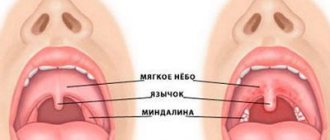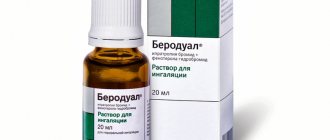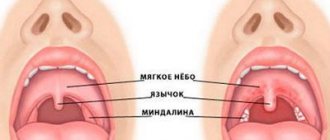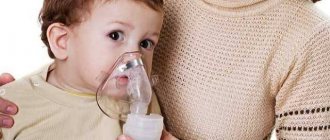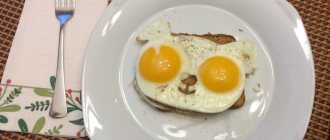Home Nasal diseases Adenoids Using Nasonex spray for children with adenoids
Adenoids are an enlargement of the tonsil located in the nasopharynx. This pathology is often recorded in children from 3 to 7 years old; it is caused by an increase in the volume of lymphoid tissue.
When carrying out drug treatment, various topical pharmaceuticals are used. One of these medications is Nasonex.
—>
- 1 Release form and composition
- 2 How does it work?
- 3 When is it used?
- 4 Is it prescribed for adenoids?
- 5 Contraindications
- 6 Can it harm a child?
- 7 Instructions for use
- 8 Features of purchase and storage
- 9 Analogues 9.1 Similar articles
Release form and composition
The drug is produced in the form of a spray. The medicine is sold in polyethylene bottles equipped with a protective cap and a spray nozzle. Vials can have different volumes, designed for different numbers of doses. The contents of the package are an opaque suspension of white or almost white color.
The active component of the medication is mometasone furoate. The active compound is a synthetic GCS. The hormone is contained in a special form - mometasone furoate monohydrate.
Additional compounds that play a supporting role are:
- sodium carboxymethylcellulose;
- MCC;
- glycerol;
- lemon acid;
- polysorbate-80;
- sodium citrate dihydrate;
- benzalkonium chloride solution;
- purified water.
The medicine has anti-inflammatory and anti-allergenic effects.
How does it work?
The active component of the drug is a synthetic glucocorticosteroid intended for local use in the form of inhalation.
A feature of mometasone is its ability to reduce the intensity of the inflammatory process and inhibit the progression of the allergic reaction, even when used in minimal quantities, in which the development of systemic effects on the body is not observed.
When using the drug in dosages recommended in the instructions for use, its absorption into the bloodstream is less than 1%.
Once on the mucous membrane, the active component of the drug inhibits the release of inflammatory mediators and affects the course of metabolic processes of arachidonic acid conversion, which helps to relieve the inflammatory process.
Under the influence of the hormone, the formation of neutrophil accumulations is prevented, which eliminates exudation and infiltration of the inflammation site.
The presence of glycerol in the drug prevents the drying out of the mucous membrane during drug therapy; this effect provides a positive effect on epithelial tissue and its regeneration.
When is it used?
The main indications for the use of Nasonex are:
- allergic rhinitis (seasonal or year-round) in patients of any age;
- exacerbation of chronic sinusitis (the drug is prescribed as part of complex therapy together with antibiotic therapy in adolescents and adults);
- prevention of moderate and severe seasonal allergic rhinitis.
It is considered optimal to start preventive use of the spray no later than 2 weeks before the expected start of the dusting period.
Nasonex is prescribed for children from 2 years of age for allergic manifestations. When treating sinusitis in children, the drug can be used from 12 years of age.
In what cases can a doctor prescribe Nasonex to a child?
Nasonex is great for seasonal rhinitis
The use of the drug is recommended by doctors for the treatment of:
- seasonal and year-round rhinitis (inflammation syndrome of the nasal mucosa) of an allergic nature. The product is also suitable for the prevention of seasonal allergic rhinitis. Doctors advise starting to use the drug 2–4 weeks before the expected period of exacerbation;
- acute sinusitis (infectious and inflammatory disease of the paranasal sinuses and nasal passages) or exacerbation of its chronic form in children over 12 years of age;
- adenoiditis in children over 2 years of age.
Is it prescribed for adenoids?
Instructions for use for children do not directly indicate the use of Nasonex spray for the treatment of adenoids. Doctors often prescribe it for children with adenoids, which is due to the drug’s ability to relieve swelling and improve nasal breathing.
Nasonex for adenoids in children is prescribed to reduce the production of mucus in the nasal cavity and nasopharynx, reduce swelling and inhibit allergic processes. Treatment of adenoiditis with Nasonex helps to reduce the size of the adenoids, but the drug is effective only at the stage of subsidence of the inflammatory process.
The drug is effective only if the cause of the development of adenoids is the frequent occurrence of allergies. If the cause of the development of adenoiditis is an infectious-inflammatory process occurring in the nasal cavity, the use of Nasonex is contraindicated.
This is due to the fact that under the influence of the drug, the body’s fight against the infection that provokes inflammation occurs. This effect of the drug contributes to the transition of the acute form of the pathological infectious-inflammatory process to the chronic one.
The use of the drug is advisable if there is 2 or 3 degree enlargement of the adenoids. At the first stage of development of the pathological process, the patient does not experience clinical manifestations, so the drug is not prescribed. The drug is used to prepare a child for surgery; it prevents further growth of the adenoids.
Correct use of the drug in the second stage makes it possible to obtain tangible positive results from drug therapy within a month.
The effect of using Nasonex in the nose for adenoids does not give an immediate result, as with instillation of vasoconstrictor drops; the therapeutic effect appears 1-1.5 weeks after starting to use the medicine.
An otolaryngologist will advise you on how to properly use the medication for adenoids. If Nasonex is instilled in accordance with its recommendations, after 1-2 weeks the child’s condition improves: he stops nasally, snoring disappears, and his nose begins to breathe normally.
The use of the medicine helps to improve the condition, which entails an increase in concentration and academic performance. This is due to the lack of oxygen in the body. Children's throats stop hurting and don't dry out, because... the normal process of gas exchange in the ENT organs is restored. Over time, children begin to get fewer colds.
Combination with other drugs
Nasonex can be combined with Loratadine
Very often, the spray is used as part of complex therapy in the treatment of adenoids and sinusitis. However, there are several features that parents need to be aware of:
- It is not recommended to use Nasonex together with vasoconstrictor drugs, as it acts as an alternative to them. Moreover, after using the drug, you should take a course of means to strengthen the walls of blood vessels to avoid nosebleeds;
Sometimes Nasonex is prescribed to patients who want to get rid of naphthyzine addiction. It relieves nasal congestion, but is not addictive.
- Nasonex goes well with other antihistamines, such as Loratadine;
- When using the spray, it is recommended to rinse the nose and gargle with various solutions. This will help free the organs from mucus and other impurities. It will also contribute to better absorption of the drug. However, it must be borne in mind that it is better to change all solutions once every two months.
Contraindications
The drug has a small list of contraindications for use that must be taken into account when prescribing a drug for the treatment of adenoids. These include:
- the presence of intolerance to the active compound or any of the components included in the drug;
- the presence of an untreated local infection, provided that the nasal mucosa is involved in the pathological process;
- the patient has an active or latent tuberculosis infection of the respiratory tract;
- the presence in the body of a bacterial, systemic viral or mycotic infection, as well as an infection provoked by the herpes simplex virus with eye damage.
In the latter case, the drug can be prescribed as an exception in agreement with the attending physician.
If the patient has suffered a nasal injury or surgery in this area, the use of the spray is prohibited until the wound has completely healed.
Contraindications and side effects from using the spray
Nosebleeds are possible when taking Nasonex.
Steroid drugs, unfortunately, have many contraindications, including:
- hypersensitivity or allergic reaction to the components of the drug. If any symptoms of intolerance appear - increased swelling, rash and itching - you should immediately stop using the product and contact either your doctor or an allergist;
- the presence in the tissues and mucous membrane of the nasopharynx of any untreated local infection. The product is not an antibiotic, therefore it does not have antibacterial or antiviral effects;
- recent surgery in the upper and lower respiratory tract, the presence of open or unhealed wounds. It is necessary to wait until the damage is completely healed;
- the presence or suspicion of the presence of tuberculosis infection in the respiratory tract, fungal, bacterial, viral infection, including infection caused by herpes, with the appearance of lesions in the eye area. When taking hormonal drugs, the process of immunity formation (immunogenesis) is disrupted, which leads to an increase in the activity of harmful microorganisms;
- age restrictions: for allergic rhinitis, the drug is approved from two years of age, for exacerbation of sinusitis and for the prevention of seasonal allergic rhinitis - from 12 years of age.
Can it harm the child?
Nasonex has a low degree of absorption, so it is not able to influence the functioning of the adrenal glands, does not provoke growth retardation and the development of mycotic infection, as well as other systemic side effects characteristic of glucocorticoids.
Theoretically, the occurrence of these problems is possible during long-term therapy with Nasonex, but clinical trials have not revealed the occurrence of these abnormalities.
During drug therapy, in rare cases, a child may experience sneezing, headaches and nosebleeds. During the use of Nasonex, irritation of the nasal mucosa may occur.
Nosebleeds that occur stop on their own and are not severe. In rare cases, the drug may provoke allergic reactions.
An overdose of mometasone can develop during long-term therapy with Nasonex in high dosages and when used in combination with other corticosteroids. As a result of this combination, the patient may experience inhibition of the function of the hypothalamic-pituitary-adrenal system.
Mometasone has a minimal degree of bioavailability, so the development of systemic side effects that would require the adoption of any therapeutic measures aimed at relieving the negative consequences of an overdose is unlikely.
A hormonal spray can suppress local immunity during drug therapy. This effect may provoke a resumption of adenoid growth after discontinuation of the drug. External manifestations of this condition are the appearance of mucus flowing down the back wall of the throat.
To prevent the development of this condition, doctors recommend taking a course of anti-inflammatory treatment for adenoid vegetations. The most effective in this situation are inhalations using a nebulizer with Cycloferon, which are supplemented by rinsing the nasopharynx using the nasopharyngeal douche technique. Such procedures should be performed in the office of an otolaryngologist.
After stopping the inflammatory process, a repeated course of taking Nasonex is not required.
Komarovsky's review of Nasonex for adenoids in children
To begin with, it must be said that Komarovsky recommends first of all paying attention to those methods that allow you to do without surgery in the process of treating adenoids. We are talking about so-called conservative treatment. According to Komarovsky, it is this that should be put in first place when it comes to getting rid of adenoids. Still, the operation, although it allows you to restore natural breathing, does not protect against the appearance of adenoids in the future. But conservative treatment, organized correctly, has a much more effective and, moreover, long-lasting result.
In principle, to achieve an effect using conservative methods, it is possible to use, among other things, Nasonex. True, Komarovsky warns that this is only possible if the adenoids have not grown too much. That is, Nasonex is able to provide support for the first or second degree of the disease. In addition, you still cannot do without additional physiotherapeutic methods.
As Komarovsky says, Nasonex has a good local effect, but does not strengthen the child’s body as a whole. Therefore, you cannot completely rely on it alone. It turns out that the doctor does not consider this remedy a panacea. And parents need to take into account that without other influences it will not be possible to rid the child of adenoids. Without taking this into account, you cannot expect a good outcome. But what reviews will parents themselves give to this drug?
Instructions for use
Before using the spray, the dispenser must be calibrated. For this purpose, you need to press the sprayer several times until a uniform stream of spray appears. A similar procedure is carried out after long-term storage of the bottle without use.
Be sure to shake the bottle containing the suspension before use. If the duration of drug therapy is long, rinsing the spray nozzle and cap with hot water is required.
To treat the nasal passages with Nasonex, you need to slightly tilt the patient's head to the side. The drug is first injected into one nostril and then into the other.
It is recommended to use the medication in the following dosage:
- If the patient is from 2 to 12 years old, 1 injection is given. In accordance with the instructions for use, the drug is used once a day. One injection contains 50 mcg of the drug, respectively, the daily dose is 100 mcg (2 injections - 1 in each nostril).
- From 12 years of age and older, 2 injections are administered into each nostril. The medicine is used once a day and, accordingly, the daily dosage is 200 mcg (4 injections - 2 in each nostril).
In exceptional cases, the drug can be used 2 times a day. With this use, the single dosage remains the same, but the daily dose is 400 mcg. If there is no therapeutic effect, the doctor may recommend increasing the single dose to 200 mcg at a time, which is 800 mcg per day. When the first improvements appear, the increased dosage is reduced to the standard one.
How to use Nasonex for adenoids
Nasonex is used for adenoids in children and adults. It must be used in accordance with the instructions, which are necessarily attached to the medicine. Also, this point should be discussed with the attending physician at the time of prescribing a course of therapy.
The specialist selects the dosage of the drug and the frequency of its use. He also decides on the duration of therapy for adenoids.
The instructions offer their own method of using the remedy:
- It is necessary to tilt the child's head to one side.
- Afterwards, shake the bottle.
- You need to make 1-3 injections of the medicinal composition into each nostril.
The otolaryngologist can increase the initial dosage of the drug if the need arises, proven by diagnostic results. It is forbidden to change the dose on your own. You should definitely consult your doctor about this.
If the spray is not used for a long time, then before the next use you will need to rinse its nozzle.
Features of purchase and storage
The medicine is dispensed in the pharmacy only with a prescription from the attending physician. The bottle containing the spray must be stored at an ambient temperature of + 2 ... + 25 ° C. Freezing the drug is unacceptable. The shelf life of the drug is 3 years.
The cost of the medicine depends on the volume of the bottle. If there are 60 doses in it, the price is 440 rubles, and if there are 120 doses of the drug in the bottle, the cost is 780 rubles.
The manufacturer does not produce Nasonex nasal drops, so the only dosage form is a nasal spray, sold in a bottle with a dispenser.
Analogs
Analogues of Nasonex may be other drugs containing mometasone. Such medications are Dezrinit and Nosephrine.
If necessary, other topical hormonal medications can be used as substitutes. Such pharmacological agents are the following:
- Avamis;
- Flixonase;
- Nasobek;
- Nazarel.
These drugs have an anti-inflammatory effect and can effectively treat adenoiditis caused by frequent exacerbations of allergies.
The following medicinal compositions have proven themselves well as substitutes:
- Euphorbium compositum;
- Thuja oil;
- Lymphomyosot;
- IRS 19.
Most of the drugs on the last list are homeopathic, so doctors’ opinions about their effectiveness differ: some recommend using them, while others speak out about their ineffectiveness. Before using any of the Nasonex substitutes, you should consult with your doctor on this issue.

